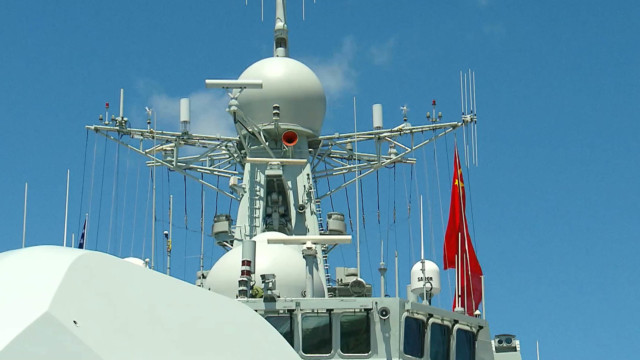China has five ships at RIMPAC, the largest naval exercise in the world, currently underway in Hawaii.
Led by the guided missile destroyer the Xi’an, the fleet represents the rapid modernization of the Chinese navy.
CCTV America’s Nathan King reported.

The Xi’an has only been in service about a year and this class of destroyer is the first with a fully long range air defense capability.
Perhaps the piece of kit Chinese are most proud of is a submarine rescue vehicle, which can actually rescue sailors at a depth of half a kilometer under the sea. It’s going to be part of an exercise with the U.S. to hone the skills of both navies should a disaster happen to any submarine in the Pacific Rim.
As China’s commitments grow, more ships like this which provides everything from fuel to food will be needed.
The big gun on the deck of the Xi’an, which leads this group of five ships and is the epitome of a modernization of the Chinese navy, that is well underway and in full show here, what it is capable of at RIMPAC 2016 in the 21st century.
RIMPAC exercise causes some tension between Washington and Beijing
The RIMPAC exercise is about enhancing security around the Pacific Rim-based on rules set by the U.S. and its allies after World War Two. But when it comes to the 1994 UN convention, the U.S. has a problem. The U.S. Congress has refused to ratify the treaty for decades.
CCTV America’s Nathan King reported.

Domestic concerns over sovereignty and economic issues has left Washington outside a system it said it supports-a system the U.S. now said China must support, too.
Even U.S. analysts express concern over the appearance of hypocrisy and bias.
“U.S. actions suggest, at a minimum, deep involvement in the conflicts in the South China Sea and increasingly taking sides on behalf of the Philippines, on behalf of Vietnam, on behalf of other claimants other than China, in fact, the attitude often seems to be anybody but China,” Ted Carpenter, senior fellow of CATO Institute said.
Even though Washington isn’t party to the convention, the U.S. Navy said it still operates within its rules.
Washington and Beijing interpret those rules differently. China objects to U.S. close surveillance of coastlines China considers its sovereign territories.
“The Asia-Pacific is at peace. This is a minor set of tensions and I think it’s about time, really, that all states in the region started to de-escalate these tensions and recognize that overarching geo-political reality. We have peace. China is not the Soviet Union. There is no major threat to shipping,” Greg Austin, professor from University of New South Wales said.
RIMPAC the official line from all navies is that they’re cooperating-regardless of The Hague decision.
All eyes here will be on statements coming out of Beijing, Washington and Manila in the coming hours.
 CGTN America
CGTN America

